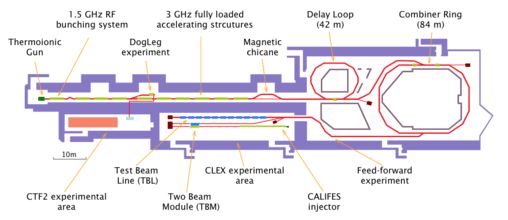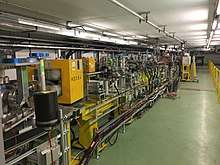CTF3 (CERN)
CTF3 (CLIC Test Facility 3) was an electron accelerator facility built at CERN with the aim of demonstrating the key concepts of the Compact Linear Collider accelerator.[1] The facility consisted in two electron beamlines to mimic the functionalities of the CLIC Drive Beam and Main Beam.
The facility stopped its operation in December 2016,[2] and one of its beamlines has been converted into the new "CERN Linear Electron Accelerator for Research" (CLEAR) facility.[3][4]
This page provides a general description of the facility with references to its main experimental program. More detailed informations can be found in the facility Design Report.[1]
Description of the facility

The facility implemented and demonstrated the feasibility of a scaled version of the CLIC Drive Beam: a 1.2 μs-long electron beam (bunched at 1.5 GHz, and with 4 A mean current) was generated and accelerated up to ~135 MeV in a ~80 m-long LINAC by using fully loaded accelerating structures powered by ~40 MW, 3 GHz RF pulses.[5] The beam was then going through a simplified version of the Drive Beam Recombination Complex (DBRC): a system composed of a delay loop and a combiner ring allowed to recombine different part of the incoming beam to finally produce a 140 ns-long train of bunches at 12 GHz and with mean current as high as 28 A.
A second electron beam of lower intensity (a few bunches of about 100 pC/bunch), called Probe Beam, was generated and accelerated up to 200 MeV in the so-called "Concept d’Accélerateur Linéaire pour Faisceau d’Electrons Sonde" (CALIFES) injector.[6] The main purpose of the Probe Beam was to emulate the main, colliding beam of CLIC.
Experimental program
The two electron beams produced at CTF3 were used to demonstrate the two-beam acceleration concept in the Two-Beam-Module installed into the CLEX experimental area: the Drive Beam was decelerated in special Power Extraction and Transfer Structures (PETS), and the power produced used to accelerate the Probe Beam with gradients as high as ~145 MeV/m.[7]
The facility served as test bed for other CLIC related R&D, for example:
- Beam Loading effect on RF breakdown rate.[8]
- Drive Beam deceleration efficiency studies.[9]
- Drive Beam phase stabilisation by using a novel feed-forward system.[10]
Evolution of the facility
Thanks to its ease of operation and versatility, the Probe Beam was used also for activities not directly connected to CLIC. This triggered the interest of various communities, and a workshop was organised to discuss possible re-use of such a beamline.[11] In December 2016, while CTF3 was ending its operation, it was then decided to transform the Probe Beam in a new general purpose R&D facility under the name of CLEAR.[3][4]
CLEAR keeps providing testing capabilities for X-band accelerator technology, including CLIC, but it also allows to explore novel concepts as plasma acceleration, THz radiation production. Furthermore, it provides electron irradiation capabilities to space and medical communities.[12]
References
- 1 2 "CTF3 Design Report" (PDF). CERN Document Server. Retrieved 2018-07-30.
- ↑ Roberto, Corsini, (May 2017). "Final Results From the Clic Test Facility (CTF3)". doi:10.18429/jacow-ipac2017-tuzb1.
- 1 2 "Official CLEAR website".
- 1 2 Gamba, D.; Corsini, R.; Curt, S.; Doebert, S.; Farabolini, W.; Mcmonagle, G.; Skowronski, P.K.; Tecker, F.; Zeeshan, S. "The CLEAR user facility at CERN". Nuclear Instruments and Methods in Physics Research Section A: Accelerators, Spectrometers, Detectors and Associated Equipment. doi:10.1016/j.nima.2017.11.080.
- ↑ Heinrich, Braun, Hans; Peter, Urschütz,; Steffen, Döbert,; Roberto, Corsini,; A, Tecker, Frank; Erk, Jensen, (2006-11-20). "Efficient long-pulse fully-loaded CTF3 linac operation".
- ↑ Navarro Quirante, Jose Luis; Corsini, Roberto; Grudiev, Alexej; Lefèvre, Thibaut; Mazzoni, Stefano; Pan, Rui; Tecker, Frank; Farabolini, Wilfrid; Peauger, Franck; Gamba, Davide; Khan, Muhammad Asif; Yaqub, Kashif; Ögren, Jim; Ruber, Roger; Vitoratou, Niki (1 December 2014). "CALIFES: A Multi-Purpose Electron Beam for Accelerator Technology Tests": MOPP030.
- ↑ Ruber, R.; Ziemann, V.; Ekelöf, T.; Palaia, A.; Farabolini, W.; Corsini, R. "The CTF3 Two-beam Test Stand". Nuclear Instruments and Methods in Physics Research Section A: Accelerators, Spectrometers, Detectors and Associated Equipment. 729: 546–553. Bibcode:2013NIMPA.729..546R. doi:10.1016/j.nima.2013.07.055.
- ↑ Tecker, Frank; Corsini, Roberto; Dayyani Kelisani, Mohsen; Döbert, Steffen; Grudiev, Alexej; Kononenko, Oleksiy; Lebet, Serge; Navarro Quirante, Jose Luis; Riddone, Germana (June 2013). "Experimental Study of the Effect of Beam Loading on RF Breakdown Rate in CLIC High-gradient Accelerating Structures": TUPME054.
- ↑ Döbert, Steffen; Adli, Erik; Lillestøl, Reidar; Olvegård, Maja; Syratchev, Igor; Carrillo, David; Toral, Fernando; Faus-Golfe, Angeles; García-Garrigós, Juan (April 2011). "Commissioning Status of the Decelerator Test Beam Line in CTF3": MOP018.
- ↑ Jack, Roberts,; Alexandra, Andersson,; Philip, Burrows,; Glenn, Christian,; Roberto, Corsini,; Andrea, Ghigo,; Fabio, Marcellini,; Colin, Perry,; Piotr, Skowroński, (June 2016). "Demonstration of CLIC Level Phase Stability using a High Bandwidth, Low Latency Drive Beam Phase Feedforward System at the CLIC Test Facility CTF3". doi:10.18429/jacow-ipac2016-wepor006.
- ↑ "CALIFES Workshop 2016 (10-12 October 2016) · Indico". Indico. Retrieved 2018-01-04.
- ↑ "The CERN Linear Electron Accelerator for Research – CLEAR (30 November 2017) · Indico". Indico. Retrieved 2018-01-04.
